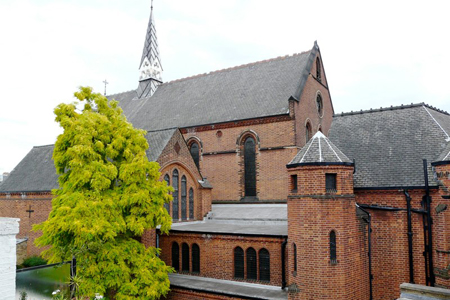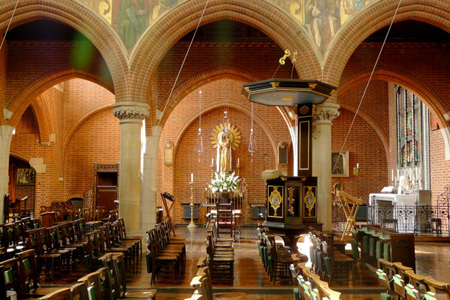| |
 |
 |
 |
| Comment on this report, or find other reports. |
 |
| Our Mystery Worshippers are volunteers who warm church pews for us around the world. If you'd like to become a Mystery Worshipper, start here. |
 |
| Find out how to reproduce this report in your church magazine or website. |
|
|
| 1691: St Mary's Bourne Street, London |
 |
 |
 |
Mystery Worshipper:
The Contemplative.
The church:
St
Mary's Bourne Street, London.
Denomination:
Church of England, Diocese
of London.
The building:
A sombre-looking dark red brick church from 1874, it squats
on the corner of two residential streets, cleverly squeezed
in among houses, and can only be seen properly from the south
side; the slender bell cote and slate roof make an interesting
contrast to the general heaviness. Inside, it is a typical Victorian
high church: heavy columns; an elaborate altar displaying the
host, gold crucifix and tall candles; an imposing pulpit, complete
with heavy tester, sitting in a rather odd position almost among
the congregation; wonderful dark carved woodwork around the
organ loft at the rear.
The church:
The church was apparently intended as a servants’ church and
to minister to nearby slums, but from the outset the toffs and
manual workers worshipped alongside one another. Now there seems
to be a mix of double-barrelled names, titles and ordinary folk.
The congregation are mostly white, with a high proportion of
men. There's a noticeable absence of young families, but evidently
they are catered for at nearby St Barnabas, which shares the
same vicar.
The neighbourhood:
This is affluent Belgravia, with fine white terraces of family
homes alongside flats, pubs, restaurants and fine-art shops
around Orange Square, with its small statue of the young Mozart
with his violin (Mozart stayed here while giving performances
and writing his first two symphonies). Victoria coach and rail
stations are nearby.
The cast:
The Revd Alasdair Coles, parish priest; the Revd Stuart Leamy,
assistant priest. The Very Revd Gilleasbuig Macmillan, minister
of St Giles' Cathedral, Edinburgh, was the guest preacher.
The date & time:
22 February 2009, 11.00am.
What was the name of the service?
High Mass.
How full was the building?
Well filled, with people occupying all the rows, not all lurking
at the back.
Did anyone welcome you personally?
Two friendly smiling ladies welcomed me and gave me the leaflet
for the service. One was selling copies of the book chosen for
the approaching Lent course, but she made no attempt to push
it onto me. People smiled or said good morning as they took
their seats around me.
Was your pew comfortable?
Rows of simple but robust dark wooden chairs with the usual slot on the back for books. Perfectly acceptable for the duration of the service.
How would you describe the pre-service
atmosphere?
The atmosphere was quiet, with a barely discernible hum of people
greeting one another. People streamed in during the 10 minutes
before the service; there were few latecomers. An atmosphere
of expectancy, as in the theatre before curtain-up.
What were the exact opening words of the
service?
"In the name of God: Father, Son and Holy Spirit, Amen."
What books did the congregation use during the
service?
New English Hymnal; Order of Service for High Mass
(purple booklet); plus leaflet containing the order of service
for Quinquagesima Sunday. The Book of Common Prayer
was in every seat also.
What musical instruments were played?
Organ, violin, cello.

Did anything distract you?
A gentleman behind me fell noisily to his knees to pray, pressing
his weight against the back of my chair; I had to lean forward
to avoid being headbutted from behind. A young child (the only
one present) babbled, sang and chortled at intervals throughout,
but this enhanced, rather than distracted – a contrast to the
overall solemnity, perhaps reminding us not to take ourselves
too seriously.
Was the worship stiff-upper-lip, happy clappy, or
what?
High Church Catholic liturgy, acted out like a piece of theatre,
proceeding smoothly in a well practised way, everyone knowing
their part, in constant movement in their colourful vestments
(green and gold predominantly). The music was superb: organist
plus an obviously professional choir of three or four voices,
with violin and cello in addition. We sang "Love Divine"
and I’ve never heard it better sung. You have to concentrate
on this kind of service, and there was a sense of a whole body
of people totally focused on worship. The order of service booklet
and the service leaflet together gave a clear outline of exactly
what was happening at every stage and made it easy for a visitor
to follow and feel involved.
Exactly how long was the sermon?
10 minutes.
On a scale of 1-10, how good was the preacher?
7 – An unemotional dry delivery, not without humour, read
from notes, like a mini lecture. No particular contemporary
references other than to carnival (it was the Sunday before
Lent). He gave an impression of deep scholarship worn lightly,
and packed a lot into a little space.
In a nutshell, what was the sermon
about?
The reading was Luke 18:31-43 (Jesus heals the blind man). The
sermon was basically on seeing and looking: the faces we wear
for different people on different occasions; how we see each
other. At carnival time many people don masks; how surprised
we might be to discover who is wearing them, seeing them as
utterly different from who we thought they were. We each have
several faces. We may be like any one or all of the seeds in
the parable of the sower – yet however unpromising the soil,
somehow the seed bears fruit; we need long term vision. The
blind man whom Jesus heard and healed saw Jesus. How do we see
Jesus, and others?
Which part of the service was like being in
heaven?
Wonderful music, hymns brought to life by organ and musicians,
and sung by us all with passion. Beautiful and witty organ voluntary
at the end. The sense of order and everything running smoothly,
with no distractions, enabling total concentration on the service.
In an elaborate service like this, the simplicity of the act
of receiving the eucharist was very moving.
And which part was like being in... er... the other place?
I could not help noting the exclusion of lay people from the
main drama, though I appreciate that this is the Anglo-Catholic
way. I felt mildly irritated by the sight of big men standing
around in pinnies doing not much.
What happened when you hung around after the service looking lost?
People streamed out, all willing to say good morning, but nothing
more.
How would you describe
the after-service coffee?
Drinks were on offer next door at the presbytery, served in
proper glasses by two pleasant ladies. They were not free –
50p juice, £2 wine – but since I was new I was not charged.
There was quite a large crowd. We stood all the time trying
to hear one another above the hubbub. There seemed to be a large
proportion of clergy. The lay people were friendly, the other
lot more reserved.
How would you feel about
making this church your regular (where 10 = ecstatic, 0 = terminal)?
3 – While this could not be my regular church because I
do not share the Anglo-Catholic way, I might return to enjoy
the focused uninterrupted order of service which so many churches
have sacrificed in favour of more social, or child-centred,
or casual style.
Did the service make you feel glad to be a
Christian?
Yes. That immediate sense of fellowship, the singing that lifted
me out of myself, the sense of purpose and focus, the worship
that gave me a real sense of the presence of God, the simple
act of receiving the bread and wine, after thorough preparation
by all that went before.
What one thing will you remember about all this in seven days' time?
The sense of truly focused waiting on God. |
|
|
 |
 |
 |
| We rely on voluntary donations to stay online. If you're a regular visitor to Ship of Fools, please consider supporting us. |
 |
 |
 |
| The Mystery Pilgrim |
 |
| One of our most seasoned reporters makes the Camino pilgrimage to Santiago de Compostela in Spain. Read here. |
 |
 |
 |
| London churches |
 |
| Read reports from 70 London churches, visited by a small army of Mystery Worshippers on one single Sunday. Read here. |
| |
|
|
|
|


